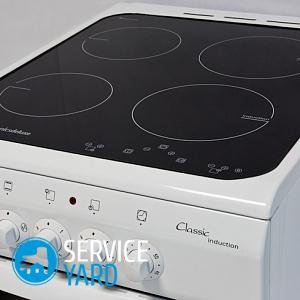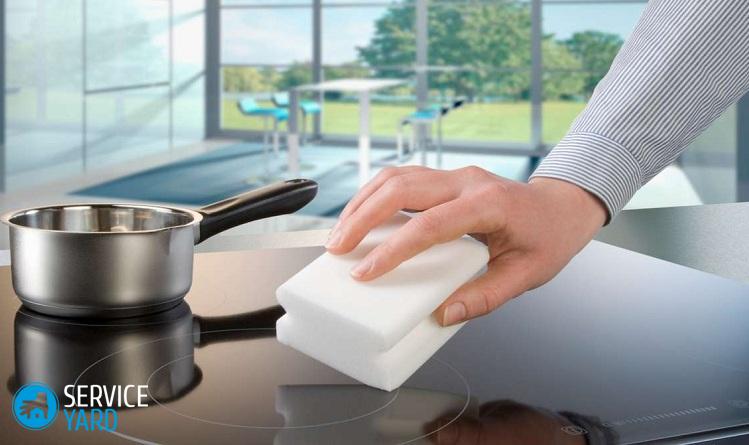How to wash a glass-ceramic stove from carbon deposits at home?

A hob made of glass ceramics is very popular. Such a stove looks respectable and luxurious, and caring for it is much easier than for a familiar enameled stove. After reading the article, you will learn how to wash a glass-ceramic stove from carbon deposits at home without any special physical and financial costs. Cleaning a ceramic stove from contaminants and food debris is a simple matter, but it has a number of nuances that you must know. These recommendations will help to quickly and efficiently clean the surface without damaging it.
to contents ↑Key Glass Ceramic Care Issues
If you have purchased a touch hob, be prepared to have to take care of it carefully. The disadvantage of the glass-ceramic surface is that the smallest fingerprints are noticeable on it, not to mention drops of oil or spilled liquid. To prevent the hob from turning into a real torture, take care of it daily. Then the stove will look really immaculate. For daily care, just use a glass cleaner.
Important! There must be a separate rag to care for the stove! It is undesirable even to use the one with which you wipe mirrors and window glasses in the house.
As you can see, there are no special difficulties associated with care. Regularity is important.
Pay attention to the following tips:
- Do not wait until the surface is very dirty. Remove stains as soon as they appear.
- Before you start cooking, make sure that the stove is dry and clean.
- Only start cleaning after the glass ceramics have cooled. Monitor the temperature of the hotplates with the indicator.
Cleaning using a wiper is carried out according to the following algorithm:
- Dampen a soft sponge or microfiber cloth with water. Put a little wiper on it.
- Put the solution on the stove. At the same time, pay special attention to stains from burnt food.
- Rinse the oven with clean water and then wipe the surface dry.
to contents ↑Important! Try to avoid small abrasive particles getting on the glass ceramic surface, as they may scratch the plate. Make sure that the pans and pots you place on the stove are dry and clean. It is especially difficult to fight when cleaning with drops of salt water.
Secrets of Proper Cleaning
How to clean an electric glass ceramic hob without much effort? Follow the rules below:
- Remove dirty stains on the surface before cooking. Otherwise, they will dry up to such an extent that it will be impossible to wash them.
- Forget metal washcloths and abrasive cleaners! They scratch the mirror surface, and the stove will very soon lose its attractive appearance.
- Remember the rule: the more often you wash the stove, the better it will look.
- Do not allow contact between the glass ceramics and the plastic parts of the dishes. The plastic will melt and stick tightly to the surface.To clean such a stain is more than problematic.
- Use the dishes without damage or dents. Do not move pots and pans over the surface - they will scratch the coating. If a scratch does appear, get a special polish to mask such damage.
- Glass-ceramic surfaces “do not like” aluminum, so you will have to part with your favorite pots from this material.
As you can see, there is nothing complicated in these preventive measures. Much easier puzzles “than to clean a glass-ceramic plate from dirt and stains”.
to contents ↑Glass ceramic cleaning at home
So, to keep the hob in a state close to perfect, you will need:
- Special scrapers equipped with interchangeable metal blades.
- Paste-like cleaners without abrasive particles.
Important! Never use a regular shaving machine to clean glass ceramics. A thin and sharp blade may scratch the hob. Even the smallest scratch not only worsens the appearance of the product, but also complicates the care of it.
Let's consider in more detail how to clean induction cookerusing various devices.
Metal blade scraper
It is ideal for removing burnt sugar or milk from the surface. Just do not delay with stain removal! Carefully clean the contamination with a blade, then wipe with a sponge and detergent. The finishing touch is to wipe the stove dry.
Rag and sponge
Do not clean the stove with the same rags and sponges that you use to clean windows and utensils. Remains of fat may remain in the sponge, which will lead to the appearance of ugly stains on the surface. A sponge soaked in dishwashing detergent leaves marks on the stove. When heated, the substance burns out, and the glass ceramics become cloudy. Therefore, in advance, separate a separate cloth and sponge to wash the glass-ceramic surface.
to contents ↑How to wash glass ceramics: household cleaning products
How to clean the dirt from the stove? Special means for glass-ceramic surfaces are well cleaned of contaminants. In addition, they form a protective silicone layer, which greatly facilitates further care of the stove. Cleaning burnt food particles and spilled liquid remains much easier. No special detergent? It doesn’t matter - an ordinary soap solution will do. After cleaning, rinse the surface with water and then wipe dry.
Wiper
According to experts, liquid for cleaning window glasses and mirrors is quite suitable for a glass-ceramic surface. Spray the liquid onto a cooled surface, then wipe with a piece of soft cloth and the stove will shine clean!
Important! Dry the surface of the stove only with a clean, dry cloth. The newspaper that our grandmothers polished the windows cannot be used.
Tile products
Some of the products for cleaning ceramic tiles and washing glass parts of the refrigerator are also suitable for glass ceramics. But be careful! Be sure to study the composition of the detergent.
to contents ↑How to clean a glass ceramic cooker: folk remedies
If you think that cleaning the stove is only possible with expensive means, this is a mistake. There are commonly available products that will make the hob sparkle and shine.
Vegetable oil
Wipe the pre-washed plate with a soft cloth moistened with a small amount of vegetable oil. This creates a protective film on the surface, and it will be much easier to wash the plate.
Olive oil is a truly miraculous remedy that helps to cope even with those impurities that could not be cleaned with a scraper. The oil application algorithm is as follows:
- Apply a little oil to a clean, dry sponge or piece of gauze.
- Put cheesecloth or sponge on the stain and leave for half an hour.
- After the dirt has softened, remove it with a sponge or scraper.
- Wash the cleaned surface with a wiper and polish with a soft cloth.
Lemon juice with baking soda
This mixture perfectly copes with cleaning the surface of a glass-ceramic plate from old stains, which even olive oil turned out to be “too tough”. Do not be afraid to scratch the surface. Of course, soda is an abrasive, but very soft. There will be no scratches on the hob, and get rid of stains:
- Mix baking soda with water until it is mushy.
- Apply soda paste to the glass ceramic surface.
- To prevent the gruel from drying out, clean the stove with a soft cloth or sponge.
- Wash away the remaining soda slurry with water to prevent the appearance of stains.
Remove the most “stubborn” spots in this order:
- Apply slurry from soda to the surface, let it dry a little.
- Dripping lemon juice over soda. In this case, the “neutralization reaction”, well known from school years, occurs, splitting the most stubborn spots.
Important! Table soda, in addition to cleaning qualities, well deodorizes the surface, eliminating the smell of food.
Vinegar
Regular table vinegar is a wonderful, environmentally friendly cleaner for glass ceramics. In addition, vinegar has a pronounced disinfecting effect, leaves no chance for bacteria and other microorganisms that are not very useful.
The procedure for using table vinegar is as follows:
- Mix vinegar and water in equal proportions.
- Pour the solution into the spray bottle.
- Spray on a glass-ceramic surface with a mixture, leave for 2-3 minutes.
- Wipe the stove with a dry cloth.
Ammonia
Ammonium is very good at stains from milk and even with stains from salt water (the main enemy of glass ceramics!). So, we prepare the “magic” cleaning solution:
- Mix 250 ml distilled water with 50 ml ammonia.
- Spray the mixture from the spray bottle onto the hob.
- After 10 minutes, rub the stove with a dry cloth.
What should not be
Now let's talk about what absolutely can not be allowed:
- Despite its strength, glass ceramics are very fragile. A point impact (for example, a fork or knife falling) can be fatal for her - the surface will immediately be covered with a grid of tiny cracks.
- Do not place cold pots and pans on a hot cooking surface, do not allow drops of cold water to get on a hot plate. Try to put the pots on the stove turned off, and only then turn on the heat. The material does not tolerate sudden changes in temperature and may become unusable.
- Try not to spill soup and milk from the pots onto the stove. Cleaning-cleaning, and prevention never hurts.
Stock footage
Take care of glass ceramics, and your assistant will thank you with a beautiful appearance and wonderful working qualities.
- How to choose a vacuum cleaner taking into account the characteristics of the house and coatings?
- What to look for when choosing a water delivery
- How to quickly create comfort at home - tips for housewives
- How to choose the perfect TV - useful tips
- What to look for when choosing blinds
- What should be running shoes?
- What useful things can you buy in a hardware store
- Iphone 11 pro max review
- Than iPhone is better than Android smartphones





